Taxation Law Assignment: CGT Implications and Depreciation of Assets
VerifiedAdded on 2022/11/29
|9
|2108
|417
Homework Assignment
AI Summary
This assignment analyzes two main issues: the capital gains tax (CGT) implications for Jasmine's various transactions, including the sale of a house, car, business, furniture, and paintings, and the inclusion of CNC machine costs in capital allowance computations for John. The assignment references the Income Tax Assessment Act 1997 (ITAA 97) and explores relevant sections concerning CGT assets, cost base, capital proceeds, and exemptions. It examines the application of small business entity concessions and the treatment of personal-use assets. The second part of the assignment focuses on depreciating assets, their effective life, and the calculation of decline in value, with a detailed analysis of the CNC machine's cost components and the commencement time for depreciation purposes. The document provides a comprehensive overview of taxation principles, including capital gains and depreciation, and their practical application to real-world scenarios.
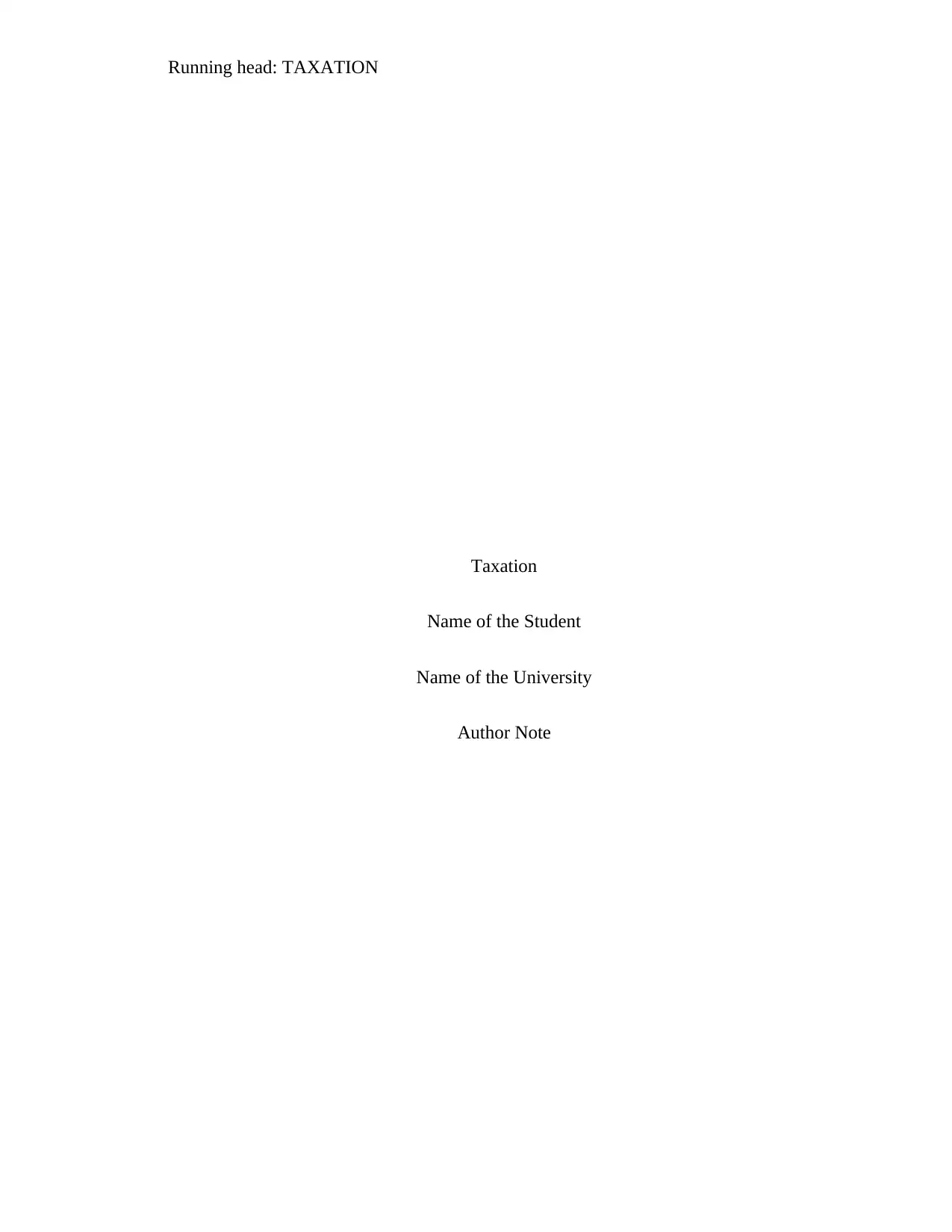
Running head: TAXATION
Taxation
Name of the Student
Name of the University
Author Note
Taxation
Name of the Student
Name of the University
Author Note
Paraphrase This Document
Need a fresh take? Get an instant paraphrase of this document with our AI Paraphraser
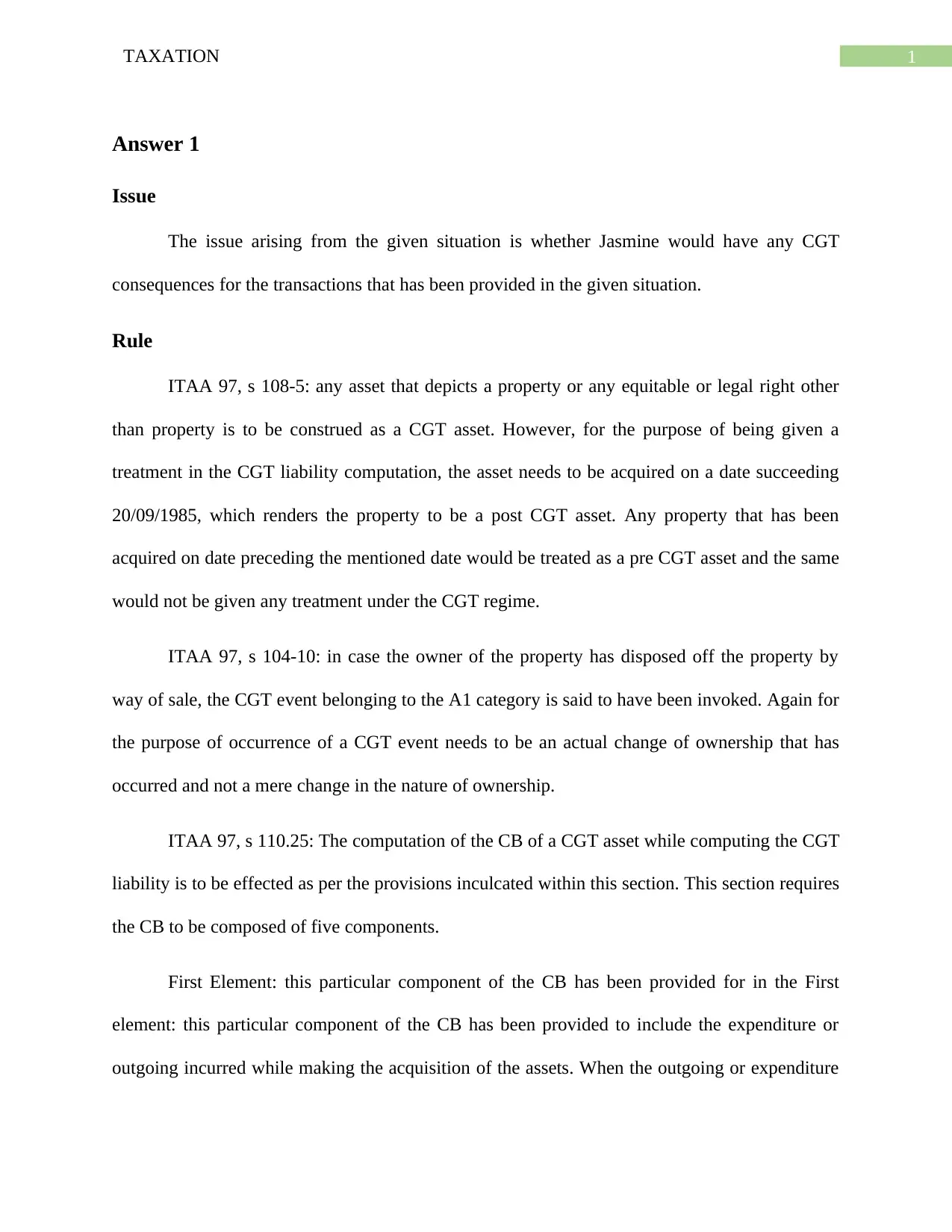
1TAXATION
Answer 1
Issue
The issue arising from the given situation is whether Jasmine would have any CGT
consequences for the transactions that has been provided in the given situation.
Rule
ITAA 97, s 108-5: any asset that depicts a property or any equitable or legal right other
than property is to be construed as a CGT asset. However, for the purpose of being given a
treatment in the CGT liability computation, the asset needs to be acquired on a date succeeding
20/09/1985, which renders the property to be a post CGT asset. Any property that has been
acquired on date preceding the mentioned date would be treated as a pre CGT asset and the same
would not be given any treatment under the CGT regime.
ITAA 97, s 104-10: in case the owner of the property has disposed off the property by
way of sale, the CGT event belonging to the A1 category is said to have been invoked. Again for
the purpose of occurrence of a CGT event needs to be an actual change of ownership that has
occurred and not a mere change in the nature of ownership.
ITAA 97, s 110.25: The computation of the CB of a CGT asset while computing the CGT
liability is to be effected as per the provisions inculcated within this section. This section requires
the CB to be composed of five components.
First Element: this particular component of the CB has been provided for in the First
element: this particular component of the CB has been provided to include the expenditure or
outgoing incurred while making the acquisition of the assets. When the outgoing or expenditure
Answer 1
Issue
The issue arising from the given situation is whether Jasmine would have any CGT
consequences for the transactions that has been provided in the given situation.
Rule
ITAA 97, s 108-5: any asset that depicts a property or any equitable or legal right other
than property is to be construed as a CGT asset. However, for the purpose of being given a
treatment in the CGT liability computation, the asset needs to be acquired on a date succeeding
20/09/1985, which renders the property to be a post CGT asset. Any property that has been
acquired on date preceding the mentioned date would be treated as a pre CGT asset and the same
would not be given any treatment under the CGT regime.
ITAA 97, s 104-10: in case the owner of the property has disposed off the property by
way of sale, the CGT event belonging to the A1 category is said to have been invoked. Again for
the purpose of occurrence of a CGT event needs to be an actual change of ownership that has
occurred and not a mere change in the nature of ownership.
ITAA 97, s 110.25: The computation of the CB of a CGT asset while computing the CGT
liability is to be effected as per the provisions inculcated within this section. This section requires
the CB to be composed of five components.
First Element: this particular component of the CB has been provided for in the First
element: this particular component of the CB has been provided to include the expenditure or
outgoing incurred while making the acquisition of the assets. When the outgoing or expenditure
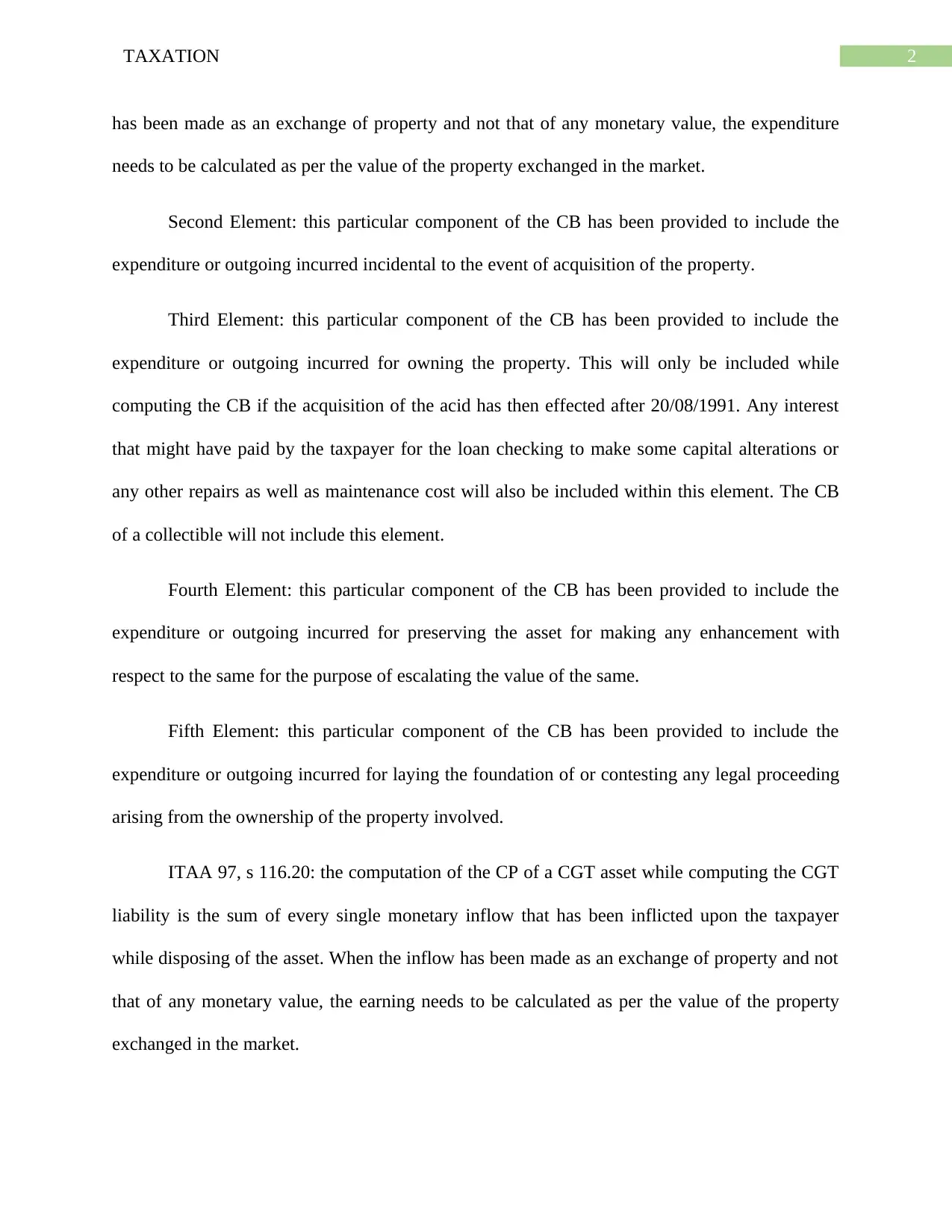
2TAXATION
has been made as an exchange of property and not that of any monetary value, the expenditure
needs to be calculated as per the value of the property exchanged in the market.
Second Element: this particular component of the CB has been provided to include the
expenditure or outgoing incurred incidental to the event of acquisition of the property.
Third Element: this particular component of the CB has been provided to include the
expenditure or outgoing incurred for owning the property. This will only be included while
computing the CB if the acquisition of the acid has then effected after 20/08/1991. Any interest
that might have paid by the taxpayer for the loan checking to make some capital alterations or
any other repairs as well as maintenance cost will also be included within this element. The CB
of a collectible will not include this element.
Fourth Element: this particular component of the CB has been provided to include the
expenditure or outgoing incurred for preserving the asset for making any enhancement with
respect to the same for the purpose of escalating the value of the same.
Fifth Element: this particular component of the CB has been provided to include the
expenditure or outgoing incurred for laying the foundation of or contesting any legal proceeding
arising from the ownership of the property involved.
ITAA 97, s 116.20: the computation of the CP of a CGT asset while computing the CGT
liability is the sum of every single monetary inflow that has been inflicted upon the taxpayer
while disposing of the asset. When the inflow has been made as an exchange of property and not
that of any monetary value, the earning needs to be calculated as per the value of the property
exchanged in the market.
has been made as an exchange of property and not that of any monetary value, the expenditure
needs to be calculated as per the value of the property exchanged in the market.
Second Element: this particular component of the CB has been provided to include the
expenditure or outgoing incurred incidental to the event of acquisition of the property.
Third Element: this particular component of the CB has been provided to include the
expenditure or outgoing incurred for owning the property. This will only be included while
computing the CB if the acquisition of the acid has then effected after 20/08/1991. Any interest
that might have paid by the taxpayer for the loan checking to make some capital alterations or
any other repairs as well as maintenance cost will also be included within this element. The CB
of a collectible will not include this element.
Fourth Element: this particular component of the CB has been provided to include the
expenditure or outgoing incurred for preserving the asset for making any enhancement with
respect to the same for the purpose of escalating the value of the same.
Fifth Element: this particular component of the CB has been provided to include the
expenditure or outgoing incurred for laying the foundation of or contesting any legal proceeding
arising from the ownership of the property involved.
ITAA 97, s 116.20: the computation of the CP of a CGT asset while computing the CGT
liability is the sum of every single monetary inflow that has been inflicted upon the taxpayer
while disposing of the asset. When the inflow has been made as an exchange of property and not
that of any monetary value, the earning needs to be calculated as per the value of the property
exchanged in the market.
⊘ This is a preview!⊘
Do you want full access?
Subscribe today to unlock all pages.

Trusted by 1+ million students worldwide
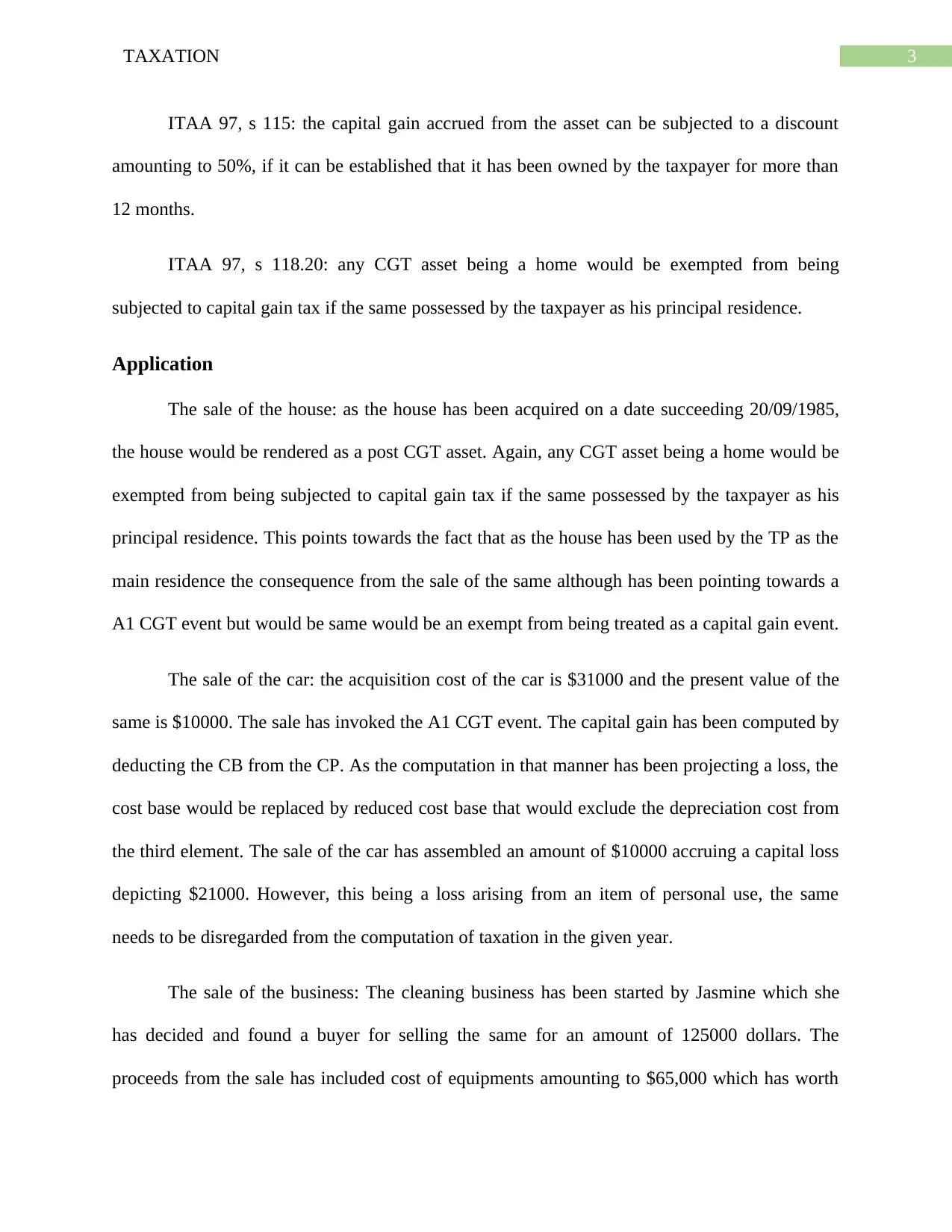
3TAXATION
ITAA 97, s 115: the capital gain accrued from the asset can be subjected to a discount
amounting to 50%, if it can be established that it has been owned by the taxpayer for more than
12 months.
ITAA 97, s 118.20: any CGT asset being a home would be exempted from being
subjected to capital gain tax if the same possessed by the taxpayer as his principal residence.
Application
The sale of the house: as the house has been acquired on a date succeeding 20/09/1985,
the house would be rendered as a post CGT asset. Again, any CGT asset being a home would be
exempted from being subjected to capital gain tax if the same possessed by the taxpayer as his
principal residence. This points towards the fact that as the house has been used by the TP as the
main residence the consequence from the sale of the same although has been pointing towards a
A1 CGT event but would be same would be an exempt from being treated as a capital gain event.
The sale of the car: the acquisition cost of the car is $31000 and the present value of the
same is $10000. The sale has invoked the A1 CGT event. The capital gain has been computed by
deducting the CB from the CP. As the computation in that manner has been projecting a loss, the
cost base would be replaced by reduced cost base that would exclude the depreciation cost from
the third element. The sale of the car has assembled an amount of $10000 accruing a capital loss
depicting $21000. However, this being a loss arising from an item of personal use, the same
needs to be disregarded from the computation of taxation in the given year.
The sale of the business: The cleaning business has been started by Jasmine which she
has decided and found a buyer for selling the same for an amount of 125000 dollars. The
proceeds from the sale has included cost of equipments amounting to $65,000 which has worth
ITAA 97, s 115: the capital gain accrued from the asset can be subjected to a discount
amounting to 50%, if it can be established that it has been owned by the taxpayer for more than
12 months.
ITAA 97, s 118.20: any CGT asset being a home would be exempted from being
subjected to capital gain tax if the same possessed by the taxpayer as his principal residence.
Application
The sale of the house: as the house has been acquired on a date succeeding 20/09/1985,
the house would be rendered as a post CGT asset. Again, any CGT asset being a home would be
exempted from being subjected to capital gain tax if the same possessed by the taxpayer as his
principal residence. This points towards the fact that as the house has been used by the TP as the
main residence the consequence from the sale of the same although has been pointing towards a
A1 CGT event but would be same would be an exempt from being treated as a capital gain event.
The sale of the car: the acquisition cost of the car is $31000 and the present value of the
same is $10000. The sale has invoked the A1 CGT event. The capital gain has been computed by
deducting the CB from the CP. As the computation in that manner has been projecting a loss, the
cost base would be replaced by reduced cost base that would exclude the depreciation cost from
the third element. The sale of the car has assembled an amount of $10000 accruing a capital loss
depicting $21000. However, this being a loss arising from an item of personal use, the same
needs to be disregarded from the computation of taxation in the given year.
The sale of the business: The cleaning business has been started by Jasmine which she
has decided and found a buyer for selling the same for an amount of 125000 dollars. The
proceeds from the sale has included cost of equipments amounting to $65,000 which has worth
Paraphrase This Document
Need a fresh take? Get an instant paraphrase of this document with our AI Paraphraser
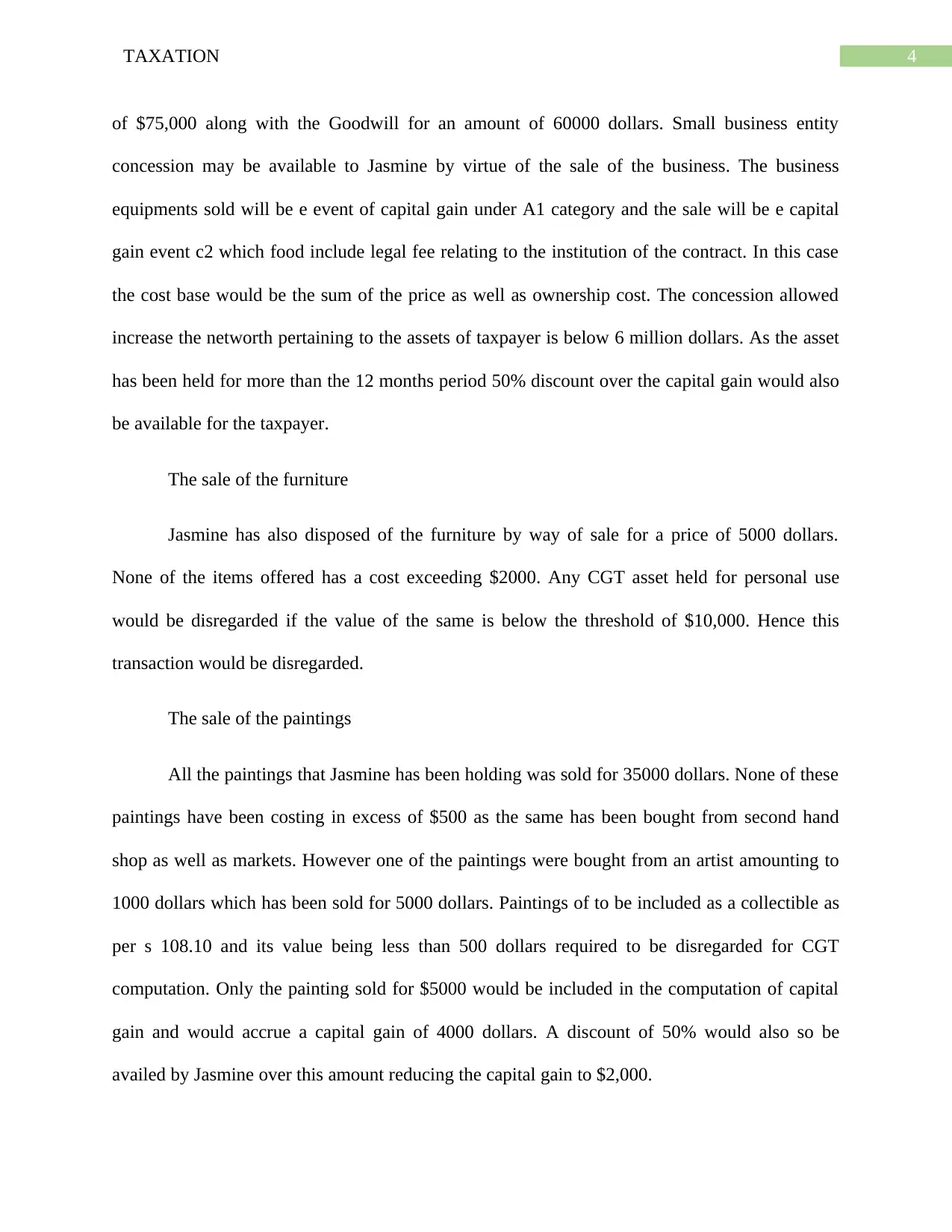
4TAXATION
of $75,000 along with the Goodwill for an amount of 60000 dollars. Small business entity
concession may be available to Jasmine by virtue of the sale of the business. The business
equipments sold will be e event of capital gain under A1 category and the sale will be e capital
gain event c2 which food include legal fee relating to the institution of the contract. In this case
the cost base would be the sum of the price as well as ownership cost. The concession allowed
increase the networth pertaining to the assets of taxpayer is below 6 million dollars. As the asset
has been held for more than the 12 months period 50% discount over the capital gain would also
be available for the taxpayer.
The sale of the furniture
Jasmine has also disposed of the furniture by way of sale for a price of 5000 dollars.
None of the items offered has a cost exceeding $2000. Any CGT asset held for personal use
would be disregarded if the value of the same is below the threshold of $10,000. Hence this
transaction would be disregarded.
The sale of the paintings
All the paintings that Jasmine has been holding was sold for 35000 dollars. None of these
paintings have been costing in excess of $500 as the same has been bought from second hand
shop as well as markets. However one of the paintings were bought from an artist amounting to
1000 dollars which has been sold for 5000 dollars. Paintings of to be included as a collectible as
per s 108.10 and its value being less than 500 dollars required to be disregarded for CGT
computation. Only the painting sold for $5000 would be included in the computation of capital
gain and would accrue a capital gain of 4000 dollars. A discount of 50% would also so be
availed by Jasmine over this amount reducing the capital gain to $2,000.
of $75,000 along with the Goodwill for an amount of 60000 dollars. Small business entity
concession may be available to Jasmine by virtue of the sale of the business. The business
equipments sold will be e event of capital gain under A1 category and the sale will be e capital
gain event c2 which food include legal fee relating to the institution of the contract. In this case
the cost base would be the sum of the price as well as ownership cost. The concession allowed
increase the networth pertaining to the assets of taxpayer is below 6 million dollars. As the asset
has been held for more than the 12 months period 50% discount over the capital gain would also
be available for the taxpayer.
The sale of the furniture
Jasmine has also disposed of the furniture by way of sale for a price of 5000 dollars.
None of the items offered has a cost exceeding $2000. Any CGT asset held for personal use
would be disregarded if the value of the same is below the threshold of $10,000. Hence this
transaction would be disregarded.
The sale of the paintings
All the paintings that Jasmine has been holding was sold for 35000 dollars. None of these
paintings have been costing in excess of $500 as the same has been bought from second hand
shop as well as markets. However one of the paintings were bought from an artist amounting to
1000 dollars which has been sold for 5000 dollars. Paintings of to be included as a collectible as
per s 108.10 and its value being less than 500 dollars required to be disregarded for CGT
computation. Only the painting sold for $5000 would be included in the computation of capital
gain and would accrue a capital gain of 4000 dollars. A discount of 50% would also so be
availed by Jasmine over this amount reducing the capital gain to $2,000.
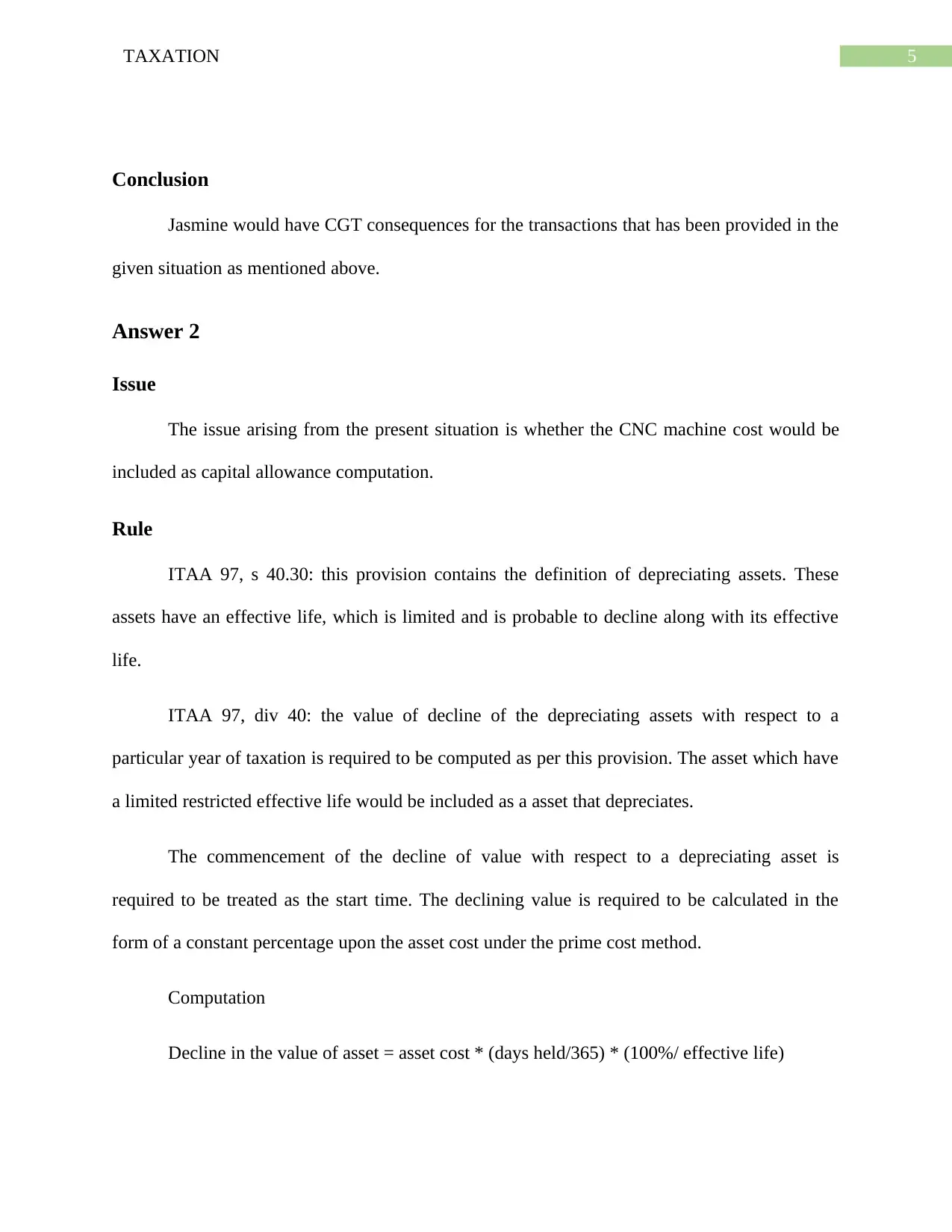
5TAXATION
Conclusion
Jasmine would have CGT consequences for the transactions that has been provided in the
given situation as mentioned above.
Answer 2
Issue
The issue arising from the present situation is whether the CNC machine cost would be
included as capital allowance computation.
Rule
ITAA 97, s 40.30: this provision contains the definition of depreciating assets. These
assets have an effective life, which is limited and is probable to decline along with its effective
life.
ITAA 97, div 40: the value of decline of the depreciating assets with respect to a
particular year of taxation is required to be computed as per this provision. The asset which have
a limited restricted effective life would be included as a asset that depreciates.
The commencement of the decline of value with respect to a depreciating asset is
required to be treated as the start time. The declining value is required to be calculated in the
form of a constant percentage upon the asset cost under the prime cost method.
Computation
Decline in the value of asset = asset cost * (days held/365) * (100%/ effective life)
Conclusion
Jasmine would have CGT consequences for the transactions that has been provided in the
given situation as mentioned above.
Answer 2
Issue
The issue arising from the present situation is whether the CNC machine cost would be
included as capital allowance computation.
Rule
ITAA 97, s 40.30: this provision contains the definition of depreciating assets. These
assets have an effective life, which is limited and is probable to decline along with its effective
life.
ITAA 97, div 40: the value of decline of the depreciating assets with respect to a
particular year of taxation is required to be computed as per this provision. The asset which have
a limited restricted effective life would be included as a asset that depreciates.
The commencement of the decline of value with respect to a depreciating asset is
required to be treated as the start time. The declining value is required to be calculated in the
form of a constant percentage upon the asset cost under the prime cost method.
Computation
Decline in the value of asset = asset cost * (days held/365) * (100%/ effective life)
⊘ This is a preview!⊘
Do you want full access?
Subscribe today to unlock all pages.

Trusted by 1+ million students worldwide
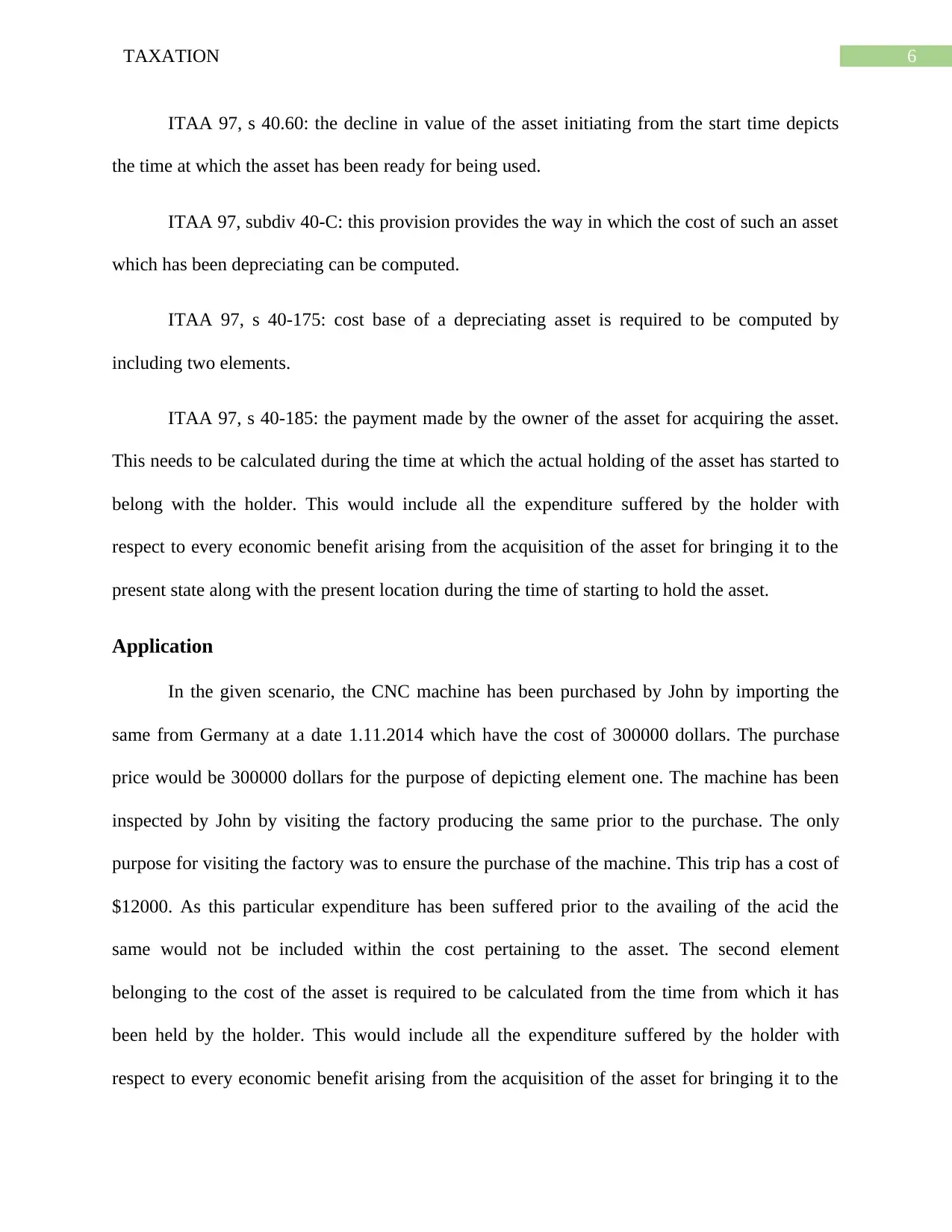
6TAXATION
ITAA 97, s 40.60: the decline in value of the asset initiating from the start time depicts
the time at which the asset has been ready for being used.
ITAA 97, subdiv 40-C: this provision provides the way in which the cost of such an asset
which has been depreciating can be computed.
ITAA 97, s 40-175: cost base of a depreciating asset is required to be computed by
including two elements.
ITAA 97, s 40-185: the payment made by the owner of the asset for acquiring the asset.
This needs to be calculated during the time at which the actual holding of the asset has started to
belong with the holder. This would include all the expenditure suffered by the holder with
respect to every economic benefit arising from the acquisition of the asset for bringing it to the
present state along with the present location during the time of starting to hold the asset.
Application
In the given scenario, the CNC machine has been purchased by John by importing the
same from Germany at a date 1.11.2014 which have the cost of 300000 dollars. The purchase
price would be 300000 dollars for the purpose of depicting element one. The machine has been
inspected by John by visiting the factory producing the same prior to the purchase. The only
purpose for visiting the factory was to ensure the purchase of the machine. This trip has a cost of
$12000. As this particular expenditure has been suffered prior to the availing of the acid the
same would not be included within the cost pertaining to the asset. The second element
belonging to the cost of the asset is required to be calculated from the time from which it has
been held by the holder. This would include all the expenditure suffered by the holder with
respect to every economic benefit arising from the acquisition of the asset for bringing it to the
ITAA 97, s 40.60: the decline in value of the asset initiating from the start time depicts
the time at which the asset has been ready for being used.
ITAA 97, subdiv 40-C: this provision provides the way in which the cost of such an asset
which has been depreciating can be computed.
ITAA 97, s 40-175: cost base of a depreciating asset is required to be computed by
including two elements.
ITAA 97, s 40-185: the payment made by the owner of the asset for acquiring the asset.
This needs to be calculated during the time at which the actual holding of the asset has started to
belong with the holder. This would include all the expenditure suffered by the holder with
respect to every economic benefit arising from the acquisition of the asset for bringing it to the
present state along with the present location during the time of starting to hold the asset.
Application
In the given scenario, the CNC machine has been purchased by John by importing the
same from Germany at a date 1.11.2014 which have the cost of 300000 dollars. The purchase
price would be 300000 dollars for the purpose of depicting element one. The machine has been
inspected by John by visiting the factory producing the same prior to the purchase. The only
purpose for visiting the factory was to ensure the purchase of the machine. This trip has a cost of
$12000. As this particular expenditure has been suffered prior to the availing of the acid the
same would not be included within the cost pertaining to the asset. The second element
belonging to the cost of the asset is required to be calculated from the time from which it has
been held by the holder. This would include all the expenditure suffered by the holder with
respect to every economic benefit arising from the acquisition of the asset for bringing it to the
Paraphrase This Document
Need a fresh take? Get an instant paraphrase of this document with our AI Paraphraser
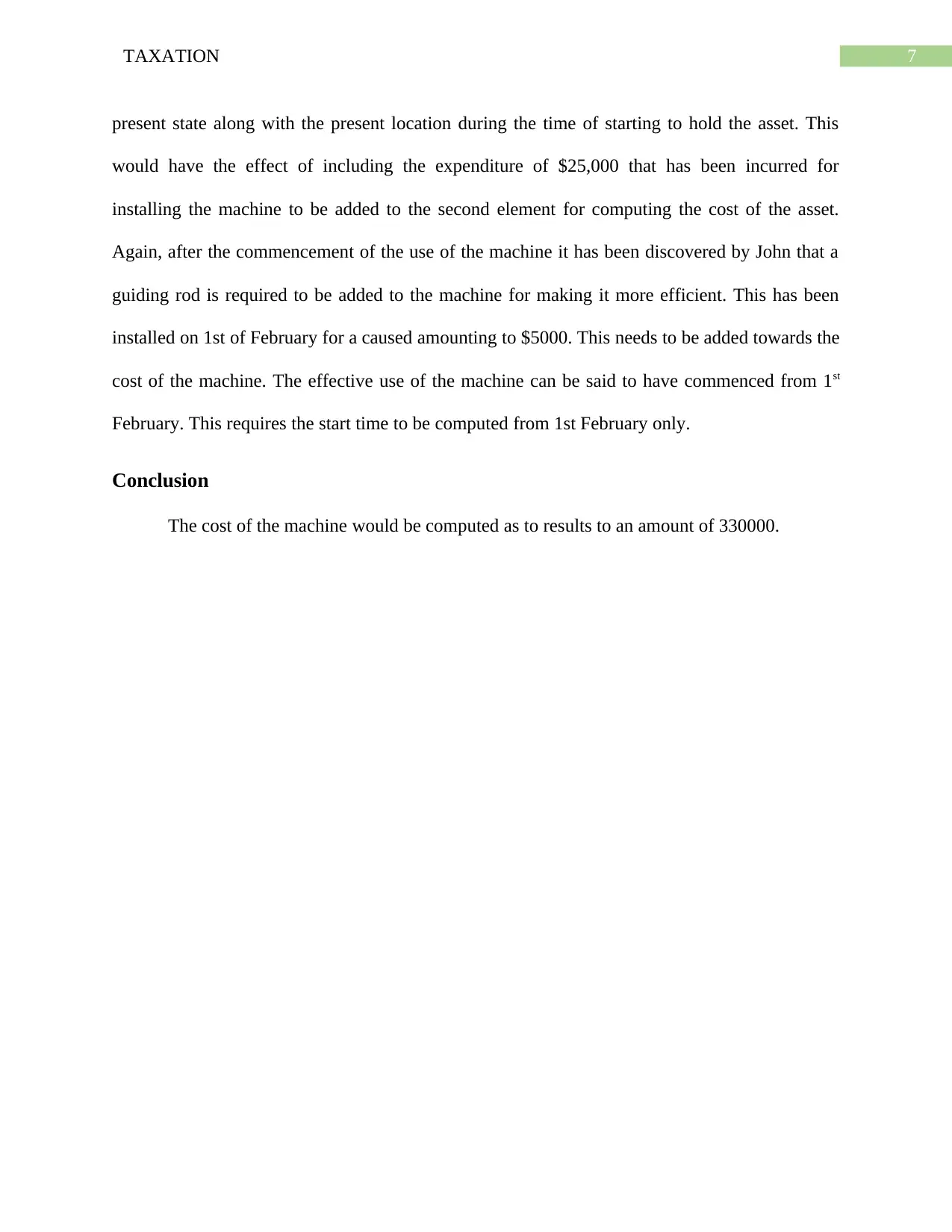
7TAXATION
present state along with the present location during the time of starting to hold the asset. This
would have the effect of including the expenditure of $25,000 that has been incurred for
installing the machine to be added to the second element for computing the cost of the asset.
Again, after the commencement of the use of the machine it has been discovered by John that a
guiding rod is required to be added to the machine for making it more efficient. This has been
installed on 1st of February for a caused amounting to $5000. This needs to be added towards the
cost of the machine. The effective use of the machine can be said to have commenced from 1st
February. This requires the start time to be computed from 1st February only.
Conclusion
The cost of the machine would be computed as to results to an amount of 330000.
present state along with the present location during the time of starting to hold the asset. This
would have the effect of including the expenditure of $25,000 that has been incurred for
installing the machine to be added to the second element for computing the cost of the asset.
Again, after the commencement of the use of the machine it has been discovered by John that a
guiding rod is required to be added to the machine for making it more efficient. This has been
installed on 1st of February for a caused amounting to $5000. This needs to be added towards the
cost of the machine. The effective use of the machine can be said to have commenced from 1st
February. This requires the start time to be computed from 1st February only.
Conclusion
The cost of the machine would be computed as to results to an amount of 330000.
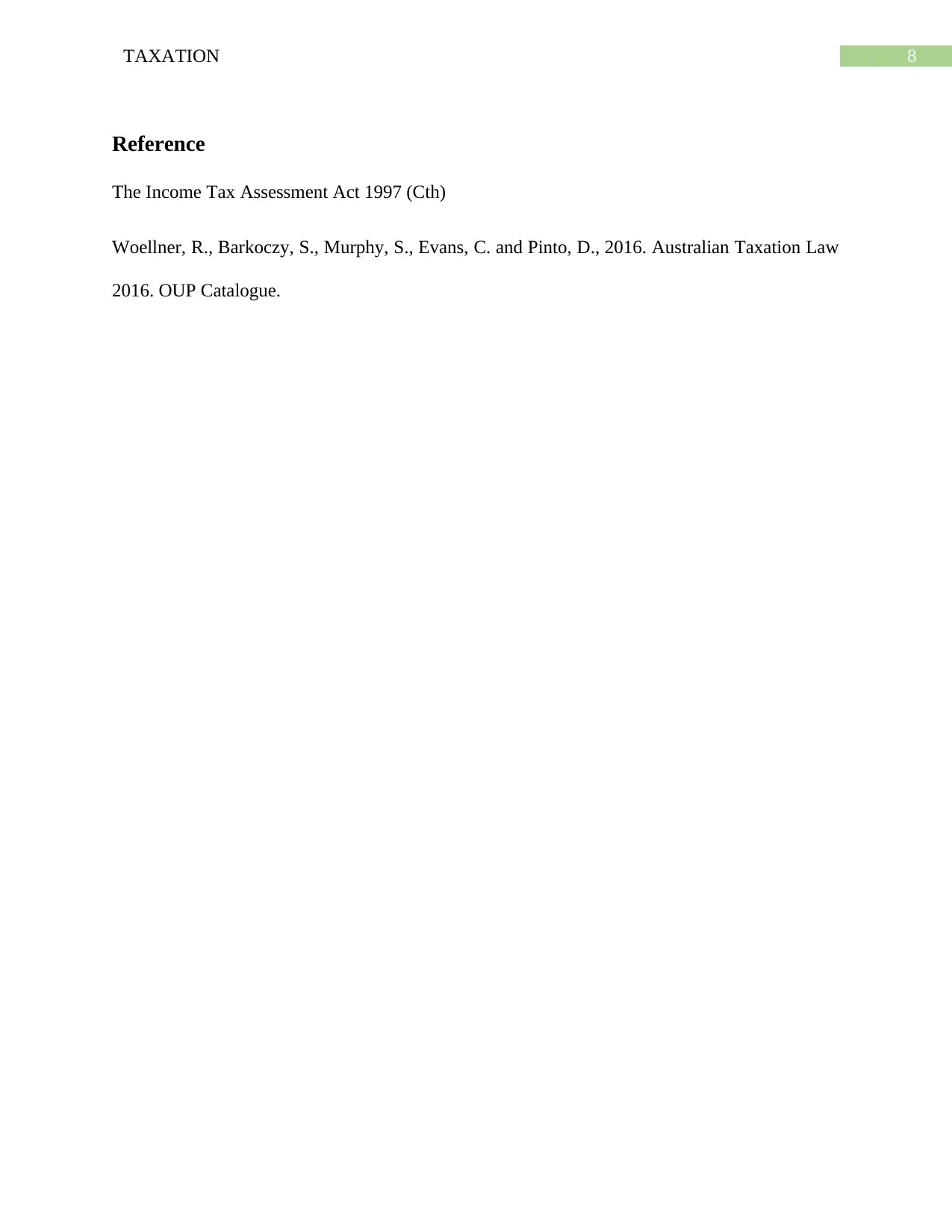
8TAXATION
Reference
The Income Tax Assessment Act 1997 (Cth)
Woellner, R., Barkoczy, S., Murphy, S., Evans, C. and Pinto, D., 2016. Australian Taxation Law
2016. OUP Catalogue.
Reference
The Income Tax Assessment Act 1997 (Cth)
Woellner, R., Barkoczy, S., Murphy, S., Evans, C. and Pinto, D., 2016. Australian Taxation Law
2016. OUP Catalogue.
⊘ This is a preview!⊘
Do you want full access?
Subscribe today to unlock all pages.

Trusted by 1+ million students worldwide
1 out of 9
Related Documents
Your All-in-One AI-Powered Toolkit for Academic Success.
+13062052269
info@desklib.com
Available 24*7 on WhatsApp / Email
![[object Object]](/_next/static/media/star-bottom.7253800d.svg)
Unlock your academic potential
Copyright © 2020–2025 A2Z Services. All Rights Reserved. Developed and managed by ZUCOL.




